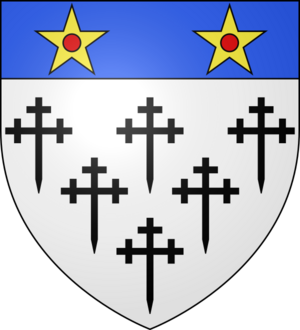Theophilus Clinton, 4th Earl of Lincoln facts for kids
Quick facts for kids
Theophilus Clinton
|
|
|---|---|
| 4th Earl of Lincoln | |
| Tenure | 1619–1667 |
| Known for | Puritan opponent of Charles I |
| Born | 1599 |
| Died | May 21, 1667 (aged 67–68) |
| Nationality | English |
Theophilus Clinton, 4th Earl of Lincoln (born 1599 – died May 21, 1667), was an important English nobleman. He was known for being a strong opponent of King Charles I. This was before and during the English Civil War, a big conflict in England. Before he became Earl in 1619, people called him Lord Clinton.
The Clinton Family
Theophilus Clinton was the oldest son of the 3rd Earl of Lincoln and Elizabeth Knyvet. He went to study at Emmanuel College, which is part of Cambridge University.
In 1616, he was made a Knight of the Bath. This was a special honor given at a ceremony for Charles, Duke of York, who later became King Charles I.
When his father passed away in 1619, Theophilus became the 4th Earl of Lincoln. In 1622, he married Bridget Fiennes. She was the daughter of William Fiennes, a powerful nobleman who later became Viscount Saye and Sele.
The Earl and Countess of Lincoln had several children, including:
- Edward Clinton, Baron Clinton (1624–1657): He married Lady Anne Holles.
- Their son, Edward Clinton, 5th Earl of Lincoln (1645–1692), later inherited the family titles.
- Lady Catherine Clinton (died 1643): She married George Booth, who became Baron Delamer.
- Lady Arabella Clinton (died 1667): She married Robert Rolle.
- Lady Margaret Clinton (died 1688): She married Colonel Hugh Boscawen.
After Bridget passed away, Lord Lincoln married Elizabeth Gorges. When Theophilus Clinton died in 1667, his grandson became the next Earl.
Standing Up to King Charles I
Lord Lincoln was a Puritan. Puritans were a group of people who wanted to make the Church of England simpler. They believed in strict religious rules. Theophilus was a strong supporter of Puritans in his home county of Lincolnshire.
He was also the son-in-law of William Fiennes, who also disagreed with the King. Lord Lincoln shared his father-in-law's views. He strongly opposed King Charles I's "forced loan." This was a tax the King made people pay without the approval of Parliament.
Lord Lincoln even shared a pamphlet that said the King was trying to get rid of Parliament. Because of his strong opposition, he was put in the Tower of London. Other people who worked for him managed to escape to America.
He also refused to sign something called the "Covenant." This was an agreement to support Parliament against the King. Because of this, he was not allowed to be part of the House of Lords. The House of Lords is one of the two parts of the British Parliament.
Helping Settle North America
Lord Lincoln was also very interested in setting up colonies in British North America. This was a big project where people from England moved to North America to start new towns.
He hired Thomas Dudley to manage his family's land in Sempringham. Thomas Dudley later became the second governor of the Massachusetts Bay Colony in America.
In 1629, an important meeting happened at Sempringham. At this meeting, John Winthrop and others planned how to organize the new Massachusetts Bay Colony.
Lord Lincoln's brother-in-law, Charles Fiennes, and his sister, Lady Arbella Johnson, also sailed to America. They went with the Winthrop Fleet, which was a group of ships that carried many early settlers to Massachusetts.


